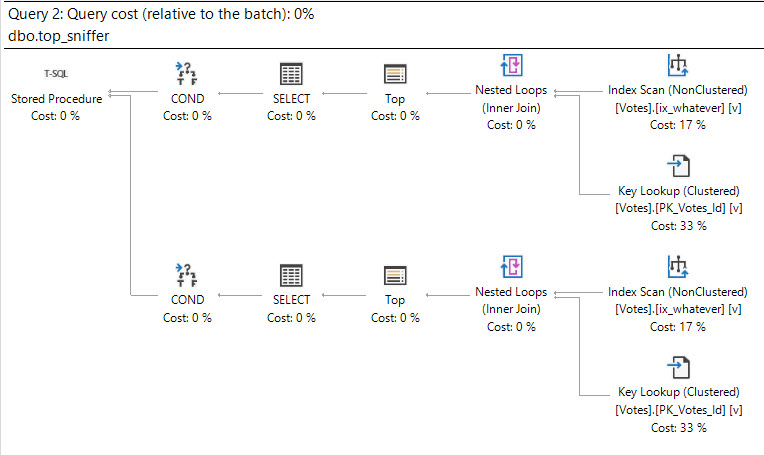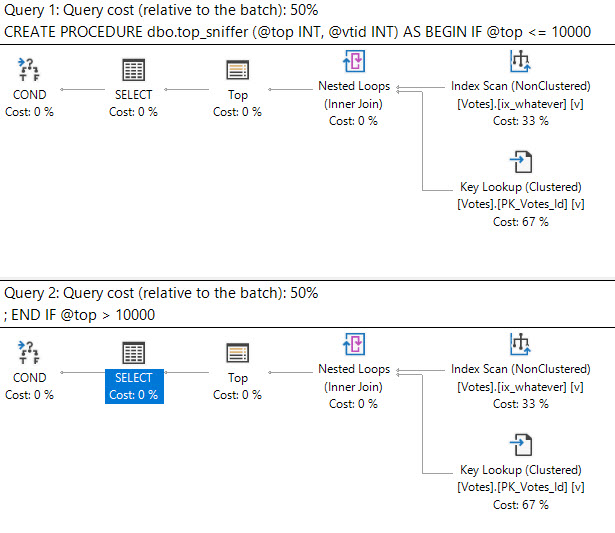Falling For Rome
Okay, so like, an IF branch in a stored procedure can be helpful to control logic, but not to control performance.
That’s the most important line in the blog post, now lemme show you why.
All Possible Permutations Thereof
Let’s say for our stored procedure, we want to use a different plan for different TOPs, and our tipping point is 10,000.
That’s the tip of our TOP, if you will. And you will, because my name’s on the blog, pal.
CREATE OR ALTER PROCEDURE dbo.top_sniffer (@top INT, @vtid INT)
AS
BEGIN
IF @top <= 10000
BEGIN
SELECT TOP (@top)
v.Id,
v.PostId,
v.UserId,
v.BountyAmount,
v.VoteTypeId,
v.CreationDate
FROM dbo.Votes AS v
WHERE v.VoteTypeId = @vtid
ORDER BY v.CreationDate DESC;
END
IF @top > 10000
BEGIN
SELECT TOP (@top)
v.Id,
v.PostId,
v.UserId,
v.BountyAmount,
v.VoteTypeId,
v.CreationDate
FROM dbo.Votes AS v
WHERE v.VoteTypeId = @vtid
ORDER BY v.CreationDate DESC;
END
END;
Soup Sandwich
This goes quite poorly. If we just get estimated plans, here’s that they produce.
/*Run me*/ EXEC dbo.top_sniffer @top = 1, @vtid = 2; /*Run me*/ EXEC dbo.top_sniffer @top = 5000000, @vtid = 2;
Contestant Number One

Contestant Number Two
The optimizer explores both paths, and the plan cache concurs.

If you were to run it with the higher value first, you’d see the same thing for the parallel plans.
Logic, Not Performance
Making plan choices with IF branches like this plain doesn’t work.
The optimizer compiles a plan for both branches based on the initial compile value.
What you end up with is a stored procedure that doesn’t do what it’s supposed to do, and parameter sniffing times two.
For a lot more information and examples, check out this Stack Exchange Q&A.
Thanks for reading!
Going Further
If this is the kind of SQL Server stuff you love learning about, you’ll love my training. I’m offering a 75% discount to my blog readers if you click from here. I’m also available for consulting if you just don’t have time for that and need to solve performance problems quickly.
If I see this pattern, I can think of two solutions
a) adding option (recompile) to the expensive part, and ensure the non-expensive plan is loaded when restarting SQL Server.
b) calling sub-stored-procedures, aka http://www.sommarskog.se
Are there other solutions?
Dynamic SQL may also work.
I don’t have access to a SQL server from my iPhone at home, but what about using OPTION (OPTIMIZE FOR (@top = 100)) in one query and a far greater value in the second? Not sure if I got that syntax correct.
Toby — yep, you can do that if you know generally safe numbers to throw in there.
Adding a local variable, while not particularly advisable, e.g. declare @big int = @top, and using @big for the 2nd block seems to shake things up.
John — IIRC, using a local variable in top gives you a flat guess of 100. Is that what you saw?
Indeed, that was a lead balloon. Apart from the previous suggestions, then, I’d throw in the towel on IF, affirming the point of this article, and just set the @top filter as predicate in respective UNION blocks. I got correct row estimates and the plus-sized @top got a parallel plan that way.
Hi John — yeah, sounds about right 🙂 Great observations!